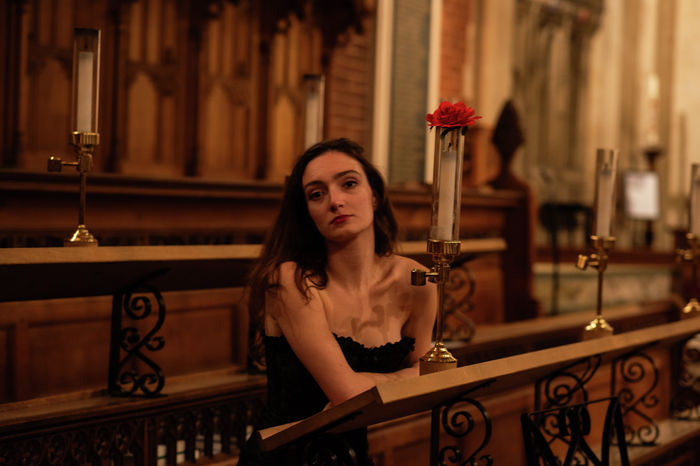Intruder / Home makes for eerie, umissable viewing
This double feature revives two masterfully-plotted gems from Maurice Maeterlinck

Intruder / Home poses many challenges to the reviewer, not least in its low lighting, prohibiting clarity of sight for the pen-and-paper writer. Yet the two plays pull and contrast with one another in an effortless display of one playwright’s talent. Intruder depicts a family anxiously awaiting a visitor, constantly looking out to avoid the ominous sickness within. Home peers inwards to a family idyll, as two would-be disruptors battle against their consciences to deliver devastating news.
For a prospective audience lacking prior knowledge of the plays, there is little to fear. The performance is approachable enough to welcome any novice. In fact, the current writer was rather surprised when a quick Google search in the interval informed her that Intruder was first performed in 1891. Both plays display an immediacy in style and message which seems more fitting to the modern stage than the Victorian one.
“Both plays employ setting sparsely but precisely”
In part, this is due to the highly commendable management of the space provided in this production. Both plays employ setting sparsely but precisely. Nothing is superfluous; every prop matters. Alice Frecheville’s costume design is also essential, opting for eerie timeless over either past or present fashion.
Maurice Maeterlinck’s narratives sit comfortably in this more timeless setting. Home, with its echoes of the death of Ophelia, transcends time even in its script. Even the mention – and later appearance – of nuns in the dialogue of Intruder does not secure the play in late-Victorian Belgium, or anywhere.
In many ways claustrophobic, Intruder contrasts with the more open Home. Placing the two plays together allows the recurring themes of sight and observation to come under great scrutiny, whilst at the same time contrasting the interior and exterior settings. In Intruder, the characters constantly look out – what is beyond the door? What is beyond the window? What is wrong with the basement? Yet Home looks inwards towards a disrupted idyll, envisioning familial bliss currently uninterrupted by the disquiet of the knowledge of the outside.
“For a prospective audience lacking prior knowledge of the plays, there is little to fear”
The peculiar dimness of the lighting – especially in Intruder – focuses the audience’s attention upon the very compact space permitted to the actors. The fading white light places the spotlight directly upon the characters who flit in and out. The Daughter (Giuila Reche-Danese) and Grandfather (Beanie Wardhaugh) spend much of their time on the periphery, emphasising their alienation from the others and yet the innate connection that they hold – even when separated by much of the stage.
Similarly, the soft blue of evening light affords Home a strange kind of coldness, akin both to the outdoor setting and the tension of the plot. Aidan Gray’s employment of sparse lighting is effective and accurate to the play.
A particular treat is the live music, arranged by Livia Bell. There is something about the presence of the string section within the theatre itself that enhances its ability to haunt and impress. Well-timed, never intrusive but always unsettling, the strings serve only to enhance two already astounding plays.
“For the most part, the acting is commendable”
For the most part, the acting is commendable: several actors switch so effectively between their parts that it is hard to recognise the doubling. Daisy Semmler (Father/Martha) and Giulia Reche-Danese (Daughter/Old Woman) deserve particular credit for this. Neither ever appears to confuse their characters, with a distinct line being drawn between the two acts.
Apparently to enhance the suffocation of Intruder, the acting in the first half is very stiff and forcefully dramatic. Away from some over-forcing of the parts by some actors, this is an effective decision on Aidan Gray’s part. The stinted form works well to stifle the scene, to keep the audience at an uncomfortable distance, in much the same way that the Grandfather (Beanie Wardhaugh) feels kept at a distance from the truth.
Although necessitated by the brevity of the plays, it is a shame that some actors appear less in one act than the other (in most cases, that their major part in Intruder leaves them with only a few lines in Home). With near-consistent skill across the board, it is inevitable that some of the actors will be lost to smaller parts.
These are poignant, challenging plays that the actors handle well. During the interval, members of the audience were audibly shaken, discussing the intensity. One recommended not sitting alone to watch the first half. But both plays are intensely original, relevant and engaging. That they have never before graced the Cambridge stages is a shock, but perhaps a result of the lack of a cast and crew strong and daring enough to perform them before. Intruder/Home is a massive undertaking (despite the short runtime) and it achieves nearly everything that it intends.
‘Intruder/Home’ is showing at the Corpus Playroom from Wednesday 27th until Saturday 30th November, at 9:30pm.
 News / Caius clock hand returned nearly 100 years after student prank31 March 2025
News / Caius clock hand returned nearly 100 years after student prank31 March 2025 News / Hundreds of jobs to be cut at Cambridge University Hospitals1 April 2025
News / Hundreds of jobs to be cut at Cambridge University Hospitals1 April 2025 Comment / More Cambridge students should study abroad 1 April 2025
Comment / More Cambridge students should study abroad 1 April 2025 Features / Cloudbusting: happy 10th birthday to the building you’ve never heard of30 March 2025
Features / Cloudbusting: happy 10th birthday to the building you’ve never heard of30 March 2025 Fashion / The Cambridge puffer: a debate 27 March 2025
Fashion / The Cambridge puffer: a debate 27 March 2025




